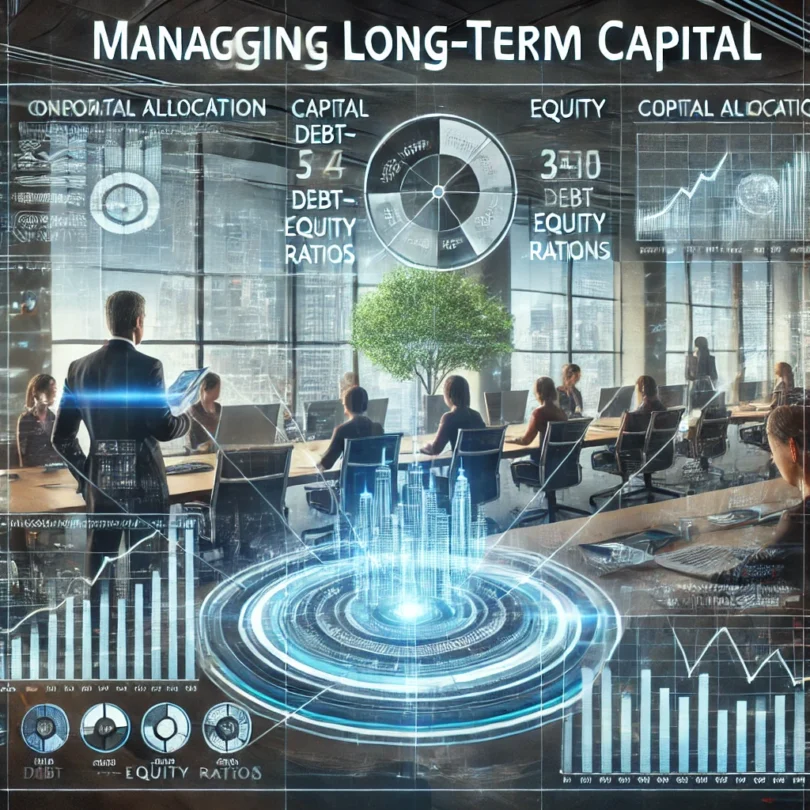Introduction
Managing long-term capital effectively is essential for the financial health and growth of any organization. Long-term capital includes funds sourced through equity, debt, and hybrid instruments, typically with a time horizon exceeding one year. Proper management ensures optimal utilization of these funds, alignment with strategic objectives, and mitigation of associated risks. This chapter explores the principles, strategies, and tools for managing long-term capital, highlighting best practices and challenges.
- Understanding Long-Term Capital Management
1.1 Definition
Long-Term Capital Management: The process of allocating, monitoring, and optimizing funds sourced for long-term purposes such as expansion, infrastructure, or debt servicing.
1.2 Objectives
Strategic Alignment
Ensure that capital supports long-term goals like growth, innovation, or sustainability.
Example: Allocating funds for renewable energy projects in line with ESG goals.
Cost Efficiency
Minimize the weighted average cost of capital (WACC) to maximize profitability.
Risk Mitigation
Balance risk across debt, equity, and hybrid financing sources.
Liquidity Management
Ensure sufficient liquidity to meet ongoing obligations while investing in long-term projects.
- Key Components of Long-Term Capital Management
2.1 Capital Allocation
Align capital with strategic priorities to maximize returns.
Example: Investing in R&D to develop innovative products.
2.2 Financial Reporting
Ensure accurate tracking and reporting of long-term capital usage.
Example: Providing quarterly updates on capital expenditure.
2.3 Performance Monitoring
Track the effectiveness of investments in achieving desired outcomes.
Example: Monitoring ROI on a new manufacturing plant.
- Strategies for Managing Long-Term Capital
3.1 Maintaining an Optimal Capital Structure
Debt-to-Equity Balance
Strike a balance between debt and equity to minimize costs and maintain flexibility.
Example: A target debt-to-equity ratio of 1.5 for manufacturing firms.
Flexibility
Avoid over-leveraging to maintain the ability to raise additional capital.
Example: Retain access to undrawn credit lines for unforeseen needs.
3.2 Efficient Capital Allocation
Prioritization Framework
Rank projects based on ROI, strategic importance, and risk.
Example: Allocate funds first to high-ROI projects with low risk.
Scenario Analysis
Use modeling to evaluate potential outcomes of capital allocation decisions.
Example: Assess the impact of allocating $100 million to new product development versus expanding production capacity.
3.3 Managing Costs of Capital
Debt Refinancing
Refinance debt to take advantage of lower interest rates.
Example: Replace a 7% loan with a 4% bond issuance.
Dividend Policies
Optimize dividend payouts to balance shareholder returns and capital retention.
Example: Retain a portion of earnings to fund future projects.
3.4 Mitigating Risks
Market Risk
Hedge against interest rate or currency fluctuations.
Example: Use interest rate swaps for variable-rate debt.
Operational Risk
Implement robust monitoring systems to track project progress and spending.
3.5 Incorporating ESG Considerations
Align long-term capital management with sustainability goals.
Example: Invest in green bonds or renewable energy projects.
- Tools and Technologies for Long-Term Capital Management
4.1 Treasury Management Systems (TMS)
Centralize management of capital flows and automate reporting.
Example: A TMS tracking long-term debt schedules and interest payments.
4.2 Financial Analytics Platforms
Use data-driven insights to evaluate capital utilization and performance.
Example: Monte Carlo simulations for project viability analysis.
4.3 Blockchain Technology
Enhance transparency and traceability of capital flows.
Example: Tokenized securities for tracking investment returns.
- Challenges in Managing Long-Term Capital
5.1 Market Volatility
Fluctuations in interest rates, currency exchange rates, and commodity prices can impact costs.
Example: Rising interest rates increasing debt servicing costs.
5.2 Regulatory Compliance
Adhering to tax laws, accounting standards, and industry-specific regulations.
Example: Compliance with IFRS for financial reporting.
5.3 Allocating Scarce Resources
Balancing competing priorities for limited funds.
Example: Deciding between international expansion and upgrading technology infrastructure.
5.4 Tracking and Reporting
Ensuring accurate, real-time monitoring of capital usage.
Example: Delayed reports leading to inefficient capital reallocation.
- Best Practices for Long-Term Capital Management
6.1 Develop a Capital Management Policy
Define Objectives
Specify goals such as cost minimization and risk management.
Set Metrics
Use KPIs like WACC, ROI, and debt coverage ratios to track performance.
6.2 Regular Reviews and Rebalancing
Conduct periodic evaluations of capital allocation.
Example: Reassess a project’s viability if market conditions change.
6.3 Enhance Stakeholder Communication
Maintain transparency with investors, lenders, and other stakeholders.
Example: Regular updates on project progress and financial health.
6.4 Invest in Technology
Leverage advanced tools for automation and data analytics.
Example: AI-driven insights for optimizing capital allocation.
- Case Study: Managing Long-Term Capital in a Global Corporation
Scenario:
A multinational retailer aims to invest $2 billion in new stores, technology upgrades, and supply chain enhancements.
Solution:
Capital Allocation
$1 billion for store expansion in high-growth regions.
$500 million for technology upgrades, including e-commerce platforms.
$500 million for logistics and supply chain optimization.
Risk Mitigation
Hedged currency exposure for international investments.
Refinanced existing debt to reduce interest costs.
Performance Monitoring
Set KPIs for store profitability, e-commerce revenue growth, and supply chain efficiency.
Outcome:
Increased revenue by 15% within three years.
Enhanced operational efficiency, reducing costs by 10%.
- Conclusion
Effective management of long-term capital is essential for achieving financial sustainability, growth, and resilience. By implementing sound strategies, leveraging technology, and maintaining transparency, organizations can optimize their use of long-term funds while mitigating risks.







Leave a Comment
You must be logged in to post a comment.